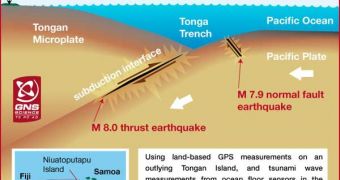In a groundbreaking new finding, a team of experts managed to establish that the devastating tsunami which struck the southwest Pacific islands of Samoa and Tonga last fall was not caused by one, but by two massive earthquakes.
At this point, details are sketchy, in the sense that scientists don't really know which of the tremors came first, or if one of them triggered the other and so on.
What they do know for sure is that two earthquakes took place, which drastically increased the probability of a tsunami developing above the location, and then heading to the nearest stretch of land.
“Here we had two events that were comparable size, yet only one made it into the catalog” that the US Geological Survey (USGS) keeps, explains Thorne Lay.
“To think that we would miss a magnitude-8 earthquake somewhere in the world is pretty amazing,” says the Lay, the lead researcher on one of the two investigations that were conducted on this issue.
The expert holds an appointment at the University of California in Santa Cruz (UCSC), LiveScience reports.
The main explanation for missing one of the tremor is that the shockwaves the first one produced masked the waves of the second one.
The finding is all the more puzzling when taking into account the fact that global seismic records and Global Positioning System (GPS) data indicated the existence of a single tremor.
Readings collected in Samoa indicated that the tsunami originated in a single, magnitude-8.1 earthquake, triggered from a normal fault line in the Pacific Plate.
But GPS data also showed that the nearby island of Niuatoputapu, which was supposed to move 30 to 40 millimeters to the west following the tremor, actually moved 400 millimeters to the east.
Though there are instances when such earthquake doublets occurred in the past, researchers say that these type of pairs of tremors are incredibly rare.
“Usually the spacing between the two is much longer, like days, weeks or a few months. This is the first time we've been able to disentangle two this close together,” says John Beavan.
He is the lead researcher of the second investigation, and is based at the GNS Science, in New Zealand. The two papers appear in the August 18 issue of the top scientific journal Nature.

 14 DAY TRIAL //
14 DAY TRIAL //